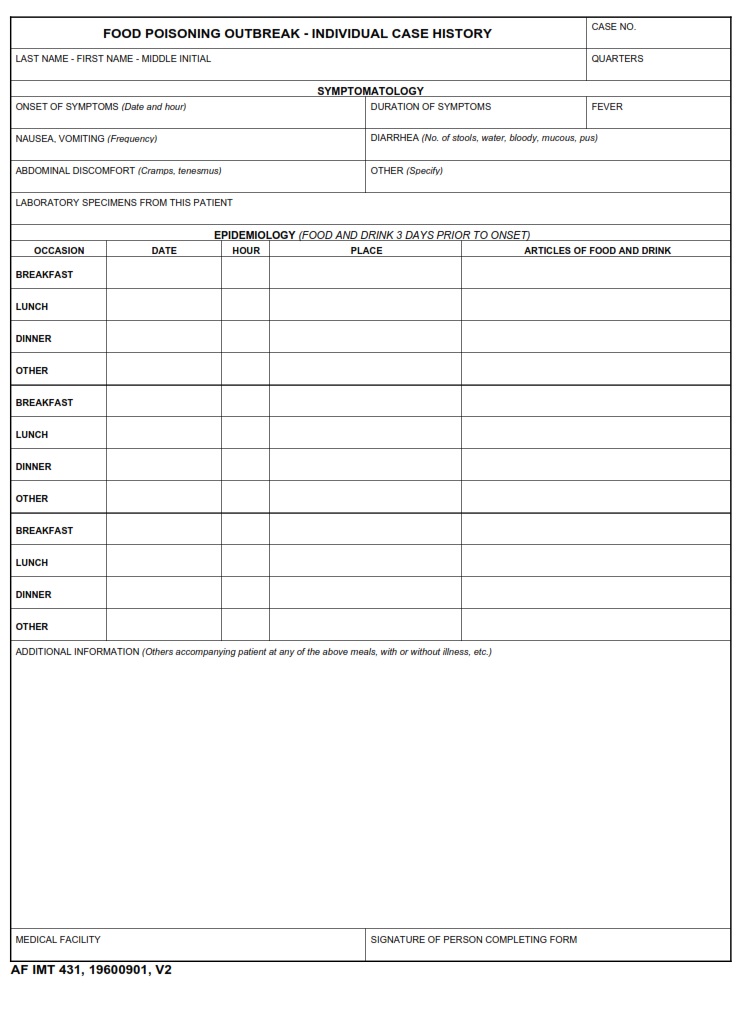AF-FORMS.COM – AF Form 431 – Food Poisoning Outbreak – Individual Case History – In the realm of food safety, the AF Form 431 stands as a crucial document that unravels the intricate web of a food poisoning outbreak. Imagine delving into the individual case history of someone who fell victim to contaminated cuisine – their journey from savoring a meal to battling an invisible enemy within. Each form tells a compelling tale of intrigue, tracing back through every morsel consumed and every symptom manifested. Join us on a gripping exploration as we dissect the narrative woven within these pages, revealing not just medical statistics but personal anecdotes and harrowing encounters with pathogens lurking in seemingly innocent dishes. The AF Form 431 transcends its bureaucratic origins to become a portal into the mysterious world of food poisoning investigations, offering insights that delve deep into both science and human experience.
Download AF Form 431 – Food Poisoning Outbreak – Individual Case History
| Form Number | AF Form 431 |
| Form Title | Food Poisoning Outbreak |
| Edition Date | 9/1/1960 |
| File Size | 31 KB |
AF-Form-431-Food-Poisoning-Outbreak-Individual-Case-History.pdf (17 downloads )
What is an AF Form 431?
The AF Form 431 is a crucial document used by military medical professionals to track individual cases of food poisoning outbreaks. This form collects detailed information about the affected individual’s symptoms, medical history, and dietary habits to identify patterns and potential sources of contamination. By meticulously documenting each case on the AF Form 431, healthcare providers can quickly analyze data to prevent further outbreaks and ensure proper treatment for those affected.
Furthermore, the AF Form 431 goes beyond just recording symptoms; it also includes a section for suspected food sources that could have caused the illness. This allows investigators to trace back the origin of the outbreak and implement necessary measures to mitigate future occurrences. The detailed information recorded on this form plays a crucial role in protecting military personnel from unnecessary health risks and ensuring swift response in case of foodborne illnesses.
Where Can I Find an AF Form 431?
Your online search for AF Form 431, a crucial document for reporting food poisoning outbreaks in the military, may lead you directly to the official Air Force website. The form is easily accessible and downloadable from their designated forms section, ensuring that accurate information can be promptly reported and action can be taken to address any health concerns within military bases or installations. Moreover, some military clinics or health units may have physical copies of AF Form 431 readily available for personnel to fill out in case of an outbreak.
For service members stationed overseas or those without immediate access to military facilities, obtaining AF Form 431 may involve contacting relevant medical personnel or public health offices for assistance. Understanding the importance of timely reporting and documentation in these situations underscores the significance of having easy access to such forms – ultimately contributing towards proactive measures in handling potential food-related threats within military communities. Efforts in streamlining processes and enhancing accessibility demonstrate a commitment to safeguarding the well-being of service members through efficient reporting mechanisms like AF Form 431.
AF Form 431 – Food Poisoning Outbreak – Individual Case History
AF Form 431, commonly known as the Food Poisoning Outbreak Individual Case History, serves as a critical tool in investigating and tracking cases of food-related illnesses within the military. This form meticulously documents key details such as symptoms experienced, duration of illness, possible sources of contamination, and any pertinent medical interventions undertaken. By compiling this information in a structured manner, health officials are better equipped to analyze trends, identify common denominators, and ultimately prevent future outbreaks.
Each individual case history recorded on AF Form 431 tells a unique story of suffering and resilience. From mild cases with brief discomfort to severe instances requiring intensive care, these records offer a glimpse into the diverse impact of food poisoning on military personnel. Moreover, beyond its immediate utility in addressing outbreaks, this form underscores the importance of robust surveillance systems and proactive measures to safeguard against potential health hazards lurking in dining facilities or during field deployments.
In essence, AF Form 431 transcends its bureaucratic origins to embody real human experiences shaped by the invisible threat of contaminated food. As military units strive for operational readiness amidst stringent hygiene protocols and quality control measures, each entry on this form echoes not just an individual’s physical ordeal but also highlights collective vulnerabilities and strengths inherent in maintaining a healthy force. Ultimately, by honing our understanding through these case histories, we fortify our defenses against an insidious enemy that can strike at any moment: foodborne illnesses.
